#sk8 the infinity meta
Explore tagged Tumblr posts
Text
I'm thinking of consumption in terms of Langa Hasegawa.
The most obvious example is one that everyone remembers, and is really just a gag for laughs; the constant eating. Having a large plate of 10 burgers and still being hungry after, the victory banquet in which his closing shot before Adam lands is chomping on a burger, the joke about him constantly asking Reki about bento, the multiple references to poutine. He's obsessed with food, and eats a lot of it. Which is perfectly normal, hes a 17 year old boy, and an athlete on top of it, of course he'll be eating a lot. But this isn't the only way in which consumption matters.
See, he's consistently slotted into the role of "Eve". Various analysts can disagree whether he actually is Eve, or whether Adam was mistaken and Eve is actually Tadashi, or whether Eve is truly nonexistent. But for the purposes of this, we're going to focus on the fact that the show references him as being Eve for a large portion of the runtime. "Eve" is the bringer of original sin, the corrupting force of "Adam". But what makes her so sinful? What makes her corrupting? Consumption. Eve eating the fruit of the tree of knowledge, consuming what is forbidden, is what makes her Eve. The very role he's put into is one of consumption, of luring others into consuming.
In this metaphor, consumption of the forbidden fruit is analogous to skateboarding. Skateboarding is consuming the forbidden fruit. The more you skate, the more you improve, the more you win, you more you keep eating that fruit. Entering the zone, then, is swallowing the final bite, finishing your meal and letting it all be consumed. But of course, Langa doesn't stay in the zone. Why? Because he wants to continue consuming, to continue to skateboard and continue to eat. If he's finished the final bite, then there's nothing else to consume. And so, he flees the zone.
This actually is quite interesting when it comes to Adam parallels, because the Matador of Love, the one who puts on a play about wanting to consume love, who skates like he wants to die, is the one who truly doesn't want to consume anymore. He wants to stop consuming, let this bite be the last. But Langa drags him out of the zone, forces him to continue consuming.
#had to pause for 10 minutes after writing 'consumption of the forbidden fruit is analogous to skateboarding'#and just. consider what my life has turned into#anyways my 5th rewatch is going great.#braincell posting#sk8#sk8 meta#sk8 the infinity#ainosuke shindo#langa hasegawa#langa#sk8 the infinity meta#sk8 analysis#sk8 the infinity analysis#langa sk8
25 notes
·
View notes
Text
SK8 Cast Image Colors, and the Super Sentai Roots of Character Color Coding
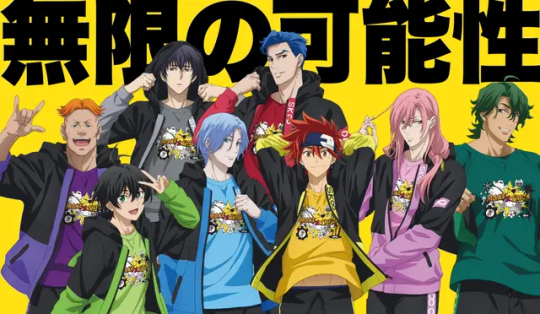
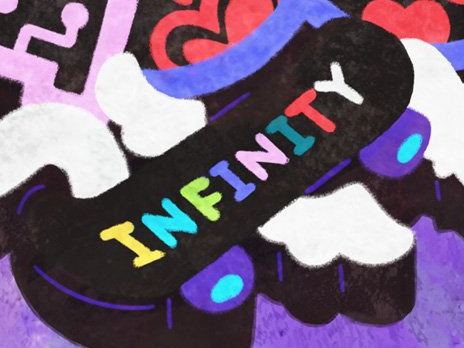
Unlike my post about hanakotoba, where only a few examples can be confirmed to be intentionally meaningful choices, image colors are an aspect of SK8's visual symbolism that has been explicitly assigned by the creators to each of the eight main cast members. From design elements to official art and merchandise (such as the art and the Infinity Week logo above) to shots in the show itself, these image colors are a consistent aspect of the series' visual language, and colors, like flowers, have meanings and associations that can provide interesting insight into why these colors were chosen for these characters. Color-coded casts are also strongly historically rooted in the super sentai subgenre of tokusatsu series, a genre that has had massive impact on Japanese pop culture, especially battle anime like SK8, in part, is, so I'll also examine the archetypes associated with their colors in super sentai (and, in Adam's case, another important piece of anime history.)
As color associations can vary by culture, I made sure to use Japanese sources - I mainly started with the dictionary on TC Color Therapy for basic color meanings but frequently checked other sources. My primary source on colors in super sentai is a paper on color theory in tokusatsu by Misako Takahashi, along with fan wikis such as Pixiv Dictionary and other Japanese blogs analyzing the subject. I also supplemented with quotes from SK8's staff when relevant.
All the image colors come from the official character guide included in volume 4 of the Blu-rays.
Reki Kyan - Yellow
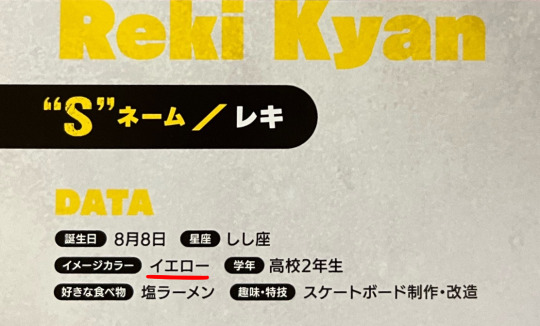
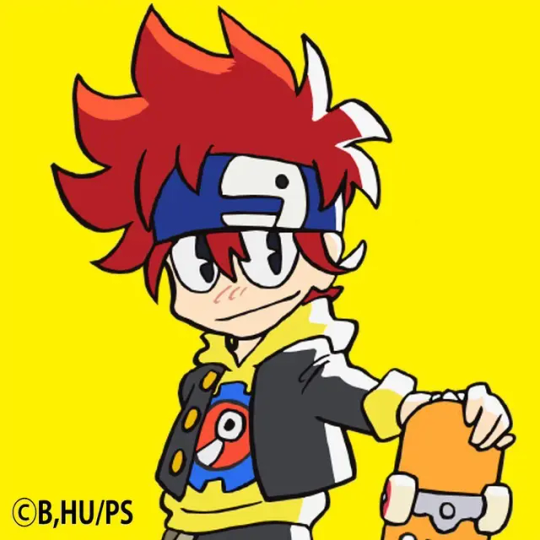
Despite his red hair, Reki's image color is yellow, the color of the signature hoodie he always wears at S. Yellow is associated with brightness, cheerfulness, fun and excitement - all things that Reki embodies at his best, and are very important parts of his character arc and what he represents to the people around him. In Utsumi's instructions to colorist Yukari Gotou, as shown in SK8 Design Works, she requested Reki's design have "so many bright and colorful primary colors it's tiring" in order to draw the eye, fitting of a bright and energetic protagonist. Yellow is a common color for team members in sentai anime, being the third most common after red and blue and appearing in the majority of series, and are often bright and cheerful "life of the party" type characters as well. This is a trend dating back to Himitsu Sentai Gorenger, the very first long-running super sentai series (beginning in 1975,) whose color coding has persisted for decades. Kirenger, the yellow member in Gorenger, was even a big eater with a signature favorite food (a trait more commonly attributed to Langa, but Reki's love for ramen and all things salty - even toothpaste - is a recurring bit in SK8 as well) and a big family.
In Takahashi's paper, she quotes another academic, Asako Yoshida's, analysis of another core aspect of yellow sentai characters, where she describes them as "an intelligent type who gathers information and forms strategies before taking action", and "rather than fighting on the front, they're a tactician who uses their wits and comes up with strategies," traits that Reki also shows frequently, especially in his biggest triumph in episode 11.
Like many of the image colors, it's also used in the show (both in the opening - highlighting his yellow-orange eyes - and in episode 11.)

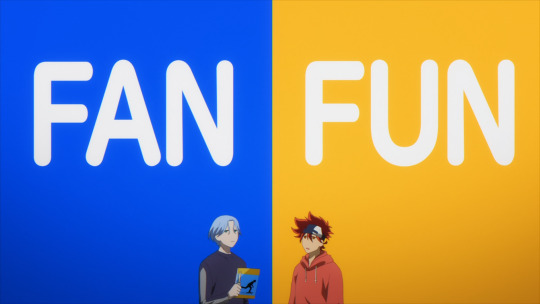
~
Langa Hasegawa - Blue
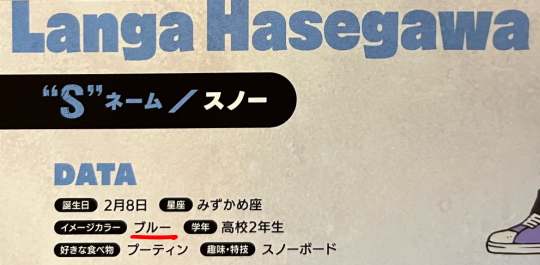
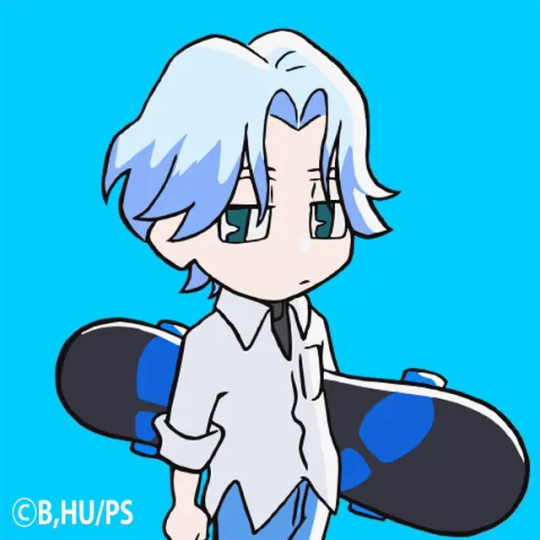
Langa's image color is blue, selected along with white from the beginning to fit his snow theme. Blue is associated with positive meanings like calmness and intelligence, but also more negative ones like coldness, sadness and loneliness, fitting of both Langa's calm exterior and the grief that's central to his storyline. Blue sentai members are classically considered "cool" characters, an association that remains strong even as actual characters of that type have grown somewhat rarer over time, with newer series sometimes deliberately subverting expectations. Like yellow, the association of blue with the cool member of a team also dates back to Gorenger, with Aorenger (the blue member) being a cool, stoic character who came from a snowy region. Takahashi quotes Yoshida's description of blue heroes as "the calm, composed and cool second in command type," a character who "doesn't worry about what's in front of him, never seems to get worked up and deals with things calmly," which certainly describes the impression Langa gives off at first - and belies what SK8's producer Kyoko Uryuu described (when comparing him to a petit gâteau) as his "surprisingly passionate" interior.
Like with Reki, Langa's color is shown off in the opening and in the show itself - notably as his "aura" when he's in the Zone with Adam.
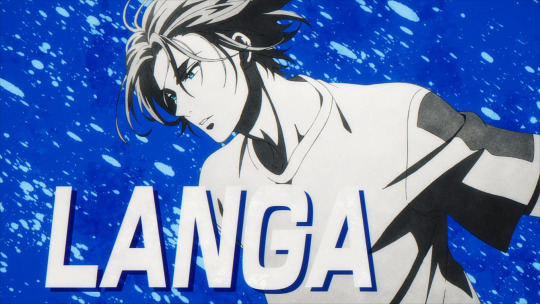
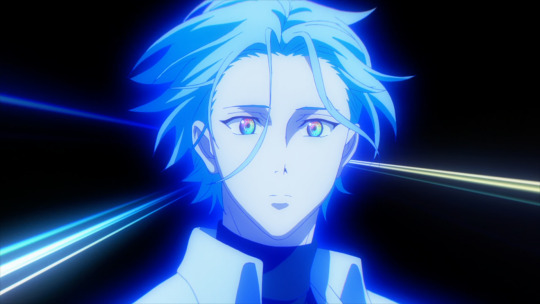
~
Miya Chinen - Light Green
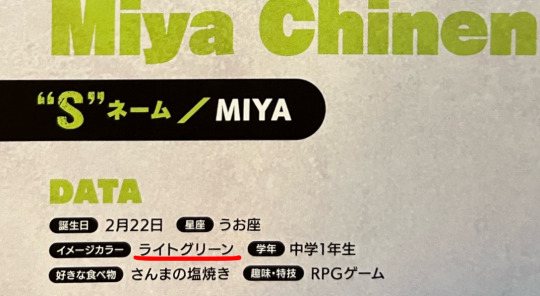
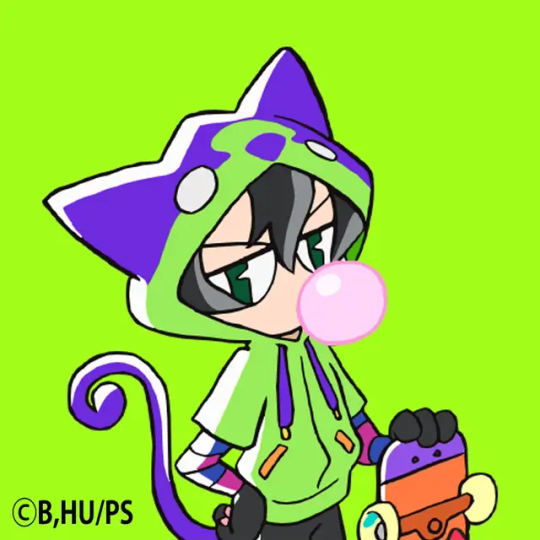
Miya's image color is light green, usually shown as a yellowish lime green. I'll get to green as a whole for Kojiro, but yellow-green specifically is associated with youthfulness, beginnings and hope, as it's the color of newly budding plants - and it can also be associated with immaturity, all meanings fitting of a very young character like Miya. While his costume is meant to be an in-universe game character, his bright green hood could also be seen as vaguely evoking Link from the Legend of Zelda series.
Green sentai characters have more varied archetypes, but were historically often the youngest member of the team, while more recently it's been a trend for them to be the oldest member of the team - fitting for the youngest and oldest members of the six characters making up SK8's main "team." The idea of a green member being the youngest also dates back to Gorenger, with Midorenger (the green member) being an innocent younger boy compared to the rest of the team, who was treated like a "mascot" of sorts and even shared Miya's affinity for animals. It's also become a trend for green characters to have close relationships with the yellow members, and to be in conflict with the red members.
Like with most of the other characters, Miya's color is highlighted in the opening.
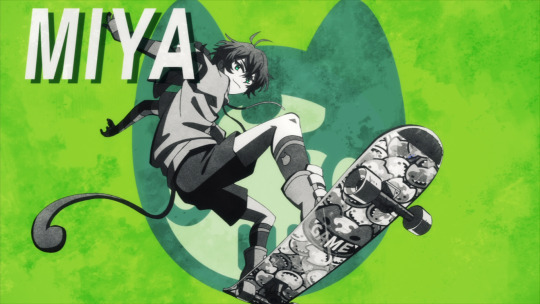
~
Hiromi Higa - Purple
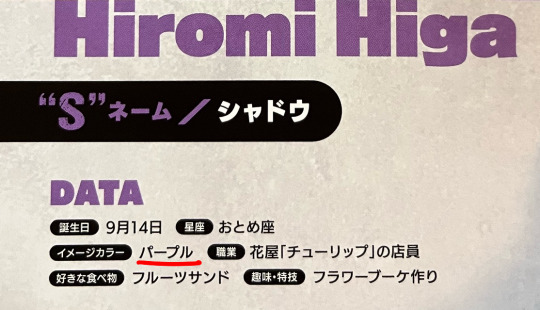
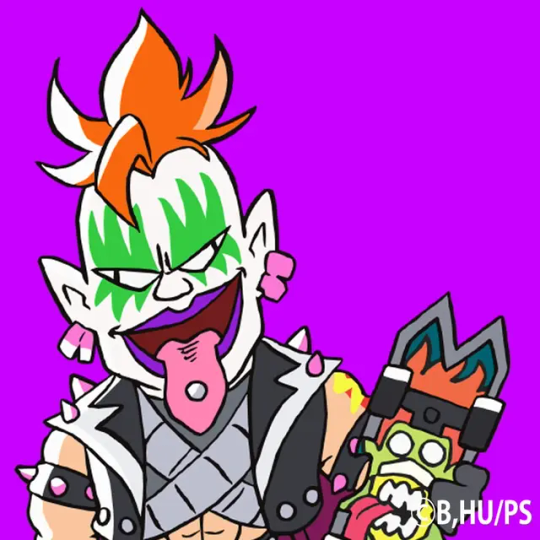
Hiromi's image color is purple, the color of his lipstick and the inside of his cape. Purple is associated with mystery, rarity, luxury and nobility, and in Japan in particular it's frequently associated with horror (from urban legends like the purple mirror to the common use of purple miasma to show disgusting/horrific food in anime.) Purple sentai members are incredibly rare, and at the time of Takahashi's paper the few that existed were usually mentor figures, but several since have been "dark heroes" or antiheroes - as "Shadow-sama" (fitting of the link to nobility) calls himself, as the self-proclaimed Antihero of the S community. With how he becomes a close friend (and even somewhat of a mentor) to the boys despite his very antagonistic first appearance, he certainly fits the "enemy-turned-ally" archetype, and while he's not actually the much older mentor early purple members were, Reki constantly calling him "old man" does evoke that trope too.
His color appears in the opening as well as featuring heavily in his S costume.
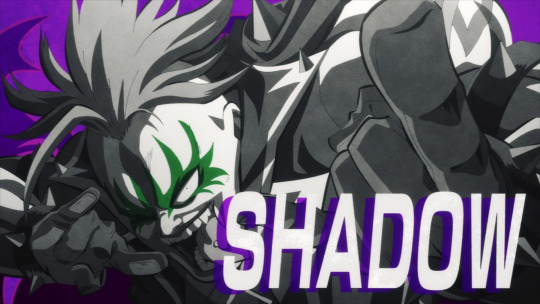
~
Kaoru Sakurayashiki - Pink
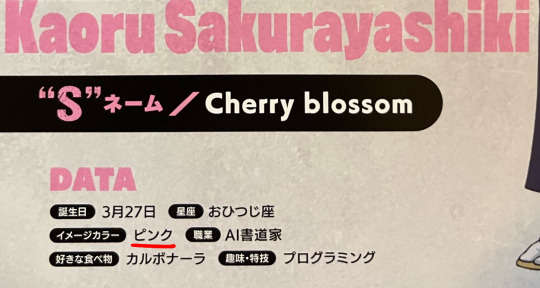

True to his surname and aesthetic, Kaoru's image color is pink, the color of cherry blossoms. Pink is associated with beauty, grace, luxury and love. Just like in the west, it's considered a very feminine color - also shown in the fact that pink sentai members are almost exclusively women, and typically particularly feminine and glamorous when on teams with other female members. This is a case where Cherry is in large part a departure from the classic color coding just because of his gender; SK8's colorist, Yukari Gotou, even expressed in Skater's Backstage that she was a bit worried about having a male character with pink hair, but Utsumi described him as a "pink ninja" from the get-go in her coloring notes.
And even Kaoru isn't completely immune to hitting the sentai archetypes either, with his noted beauty and a concern for his looks that Kojiro mocks as effeminate in the series; the contrast between the feminine characteristics he has and his masculine voice and personality are a core part of how his character was designed. He even has a surprising connection with Momorenger (Gorenger's pink member, and only woman) in his affinity for kicks. (As of 2022, there's also finally been a male character properly featuring as the pink member in a sentai series in Avataro Sentai Donbrothers.)
Of course, on top of featuring so heavily in his design, Cherry's color is also used in the opening.
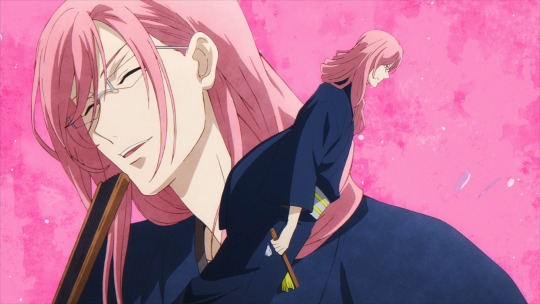
~
Kojiro Nanjo - Green
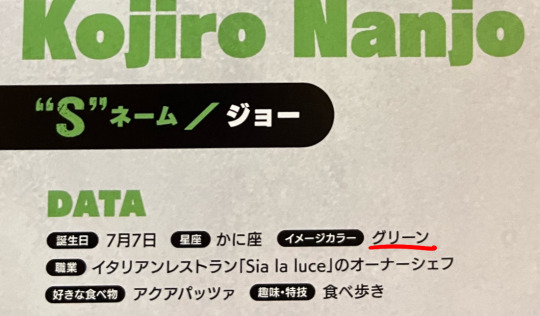

Rather than Miya's light green, Kojiro's image color is a regular green. Green is associated with calmness, stability, growth and nature, fitting for a very calming and stable mentor character who just "goes with his feelings" like Kojiro - but like light green, it can also signify immaturity, which also suits a character who proudly proclaims to be a "kid" when he's on vacation. Where Miya fits the "youngest member" trope for green sentai members, Kojiro fits the "oldest member" trope, and he also fits the recently trendy close relationship with yellow and conflict with red. In Takahashi's paper, she quotes Yoshida describing green characters as a whole as "a caring type who's always concerned if things are peaceful" (also fitting of Miya, who's always the most concerned for Reki and Langa,) "a soothing person who makes you feel warm and comforted just by being next to them" and as someone who "loves their friends, and 'being together with everyone' is important to them," and in Utsumi's color notes in SK8 Design Works, she described Kojiro as "A calming, mature green. Comforting."
And like with the others, on top of being his hair color, Kojiro's color is also shown in the opening.

~
Ainosuke Shindo - Red
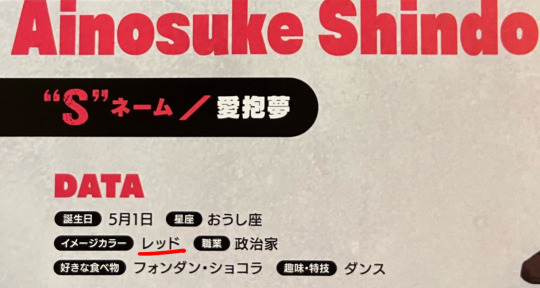
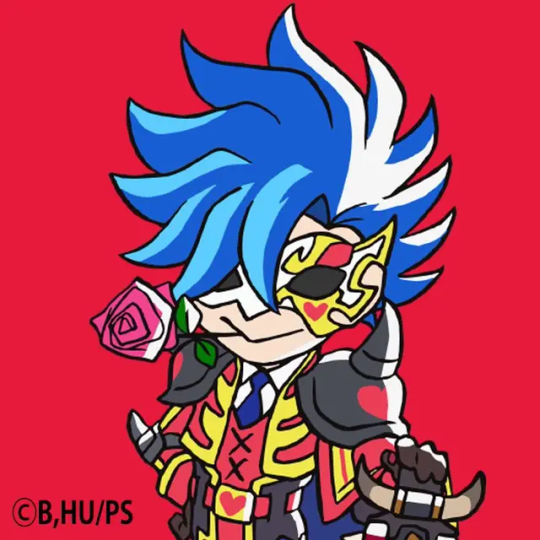
Naturally for the "Matador of Love", Adam's image color is red, a color associated with love, passion and excitement, but also danger and anger, covering both sides of the duality of Adam's connection with love and romance and his violent skating. Utsumi's color notes in SK8 Design Works describe it as "the color of love and blood", and described Adam himself as "a guy who stole a main character's color" - fitting of the fact that in sentai series (and many anime influenced by them,) the red member is almost always the main protagonist and leader. (And perhaps a cheeky reference to Reki, though it seems Adam's color was decided on much earlier on.) Between red and blue being tied for their inclusion in sentai series and yellow in a close second place, the three primary colors form a core trio of characters in sentai series that's also reflected by Reki, Langa and Adam as the three most central characters in SK8.
While many works follow Gorenger's lead with the red protagonist being a hot-headed, passionate natural leader (a role that Adam does command at S as a whole, at least at first,) it's covered such a wide spectrum of protagonists over the course of the genre's history that red's biggest association is simply "being the main character," superseding a single specific character archetype. To momentarily dip into the history of anime itself rather than tokusatsu's influence, I'd be remiss not to mention that thanks to the influence of Mobile Suit Gundam (a franchise that both writer Okouchi and character designer Chiba have history with and mentioned in interviews on Febri as inspiring their interest in anime) it does have a memetic association with speed (and rival characters,) as Gundam's frequently-imitated masked antagonist Char Aznable's custom red mecha is notoriously "three times faster" than any other. (Adam's voice actor, Takehito Koyasu, has even played two "Char Clones" himself.)
As with the other characters, Adam's color appears in the opening but it also surrounds him frequently in the show even from his first appearance, including a red glowing aura to mirror Langa's blue when they're in the Zone (even in the finale when the red is gone from his costume.)
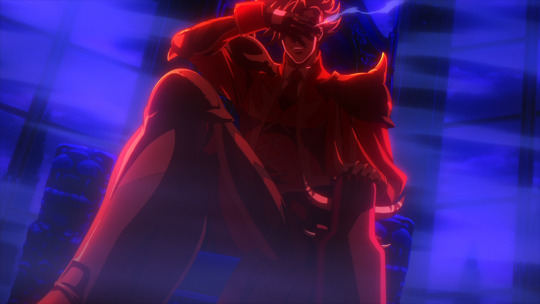
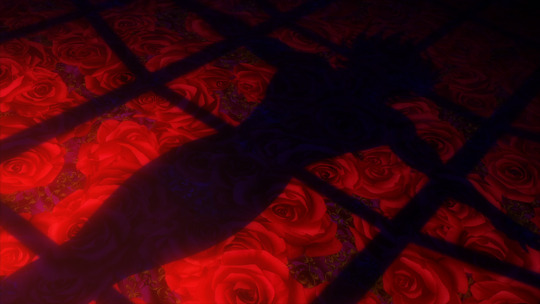
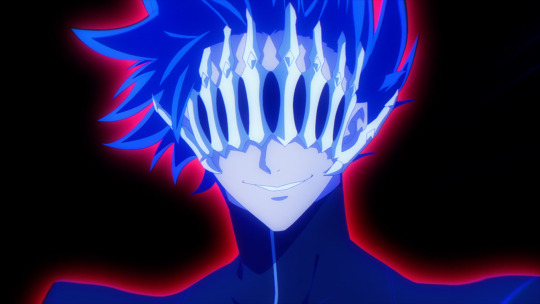
~
Tadashi Kikuchi - Gray
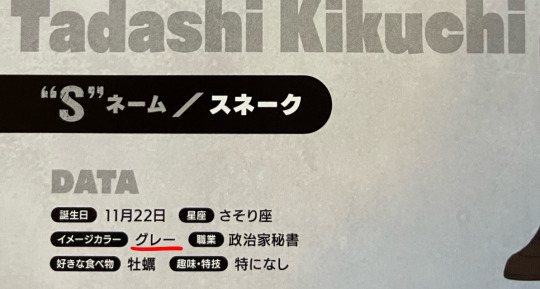
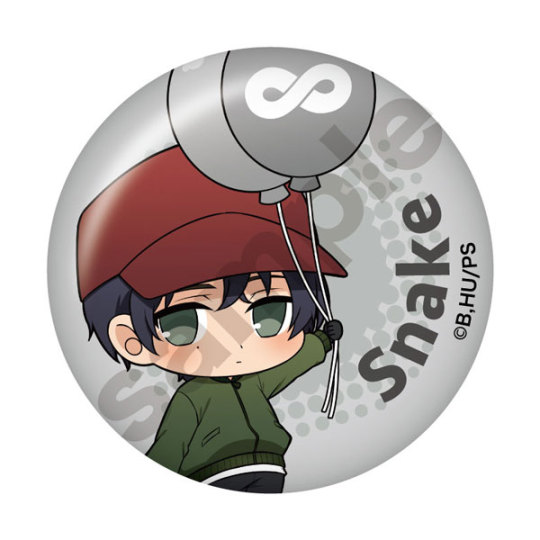
(Tadashi never got an official Twitter icon like the other characters, so I used a different piece of merch.)
Lastly, Tadashi's image color is gray, which is mostly known for being... a bit of a non-color, though it can be associated with gloom, ambiguity or uneasiness. It's mostly seen as a color that blends in and doesn't stand out by itself, which was the purpose behind Tadashi's color scheme, as Utsumi described in her notes as wanting his coloring to "make the main character stand out", given that he was designed from the beginning to appear alongside Adam, who has the "main character's color." Gray is an incredibly rare theme color in sentai series, to the point that there aren't specific character archetypes either; in 2014, at the time of Takahashi's paper, the only gray character she noted was a literal ghost. Even Tadashi's image color is alienated from the other skaters'...
While there are comparatively few (and less obvious) examples of Tadashi's image color appearing in the show, his last emotional scene with Ainosuke takes place in an almost entirely gray room.
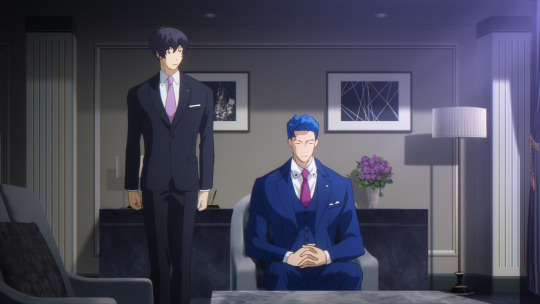
It'll be interesting to see how these associations might continue to be used in the future.
#sk8#sk8 the infinity#meta#sk8 meta#reki kyan#langa hasegawa#miya chinen#hiromi higa#shadow sk8#kaoru sakurayashiki#kojiro nanjo#ainosuke shindo#adam sk8#tadashi kikuchi
112 notes
·
View notes
Text
so this is the thing i was working on that made me decide to do that poll and go over the timeline first, kind of to preempt anyone who might argue about the placement here - adam's backstory in chronological order!
the flashbacks are scattered across several episodes so i thought it would be an interesting and useful reference to put them all in one video in order like this (and i also resubbed the scenes myself at the same time just for my own satisfaction with the translation)
and for some extra information, according to the concept art book, ainosuke is 6 years old in the first two early childhood flashbacks (and probably 7 in the third, as it looks like it's in the following summer), 17-18 in the first high school flashback and 18 in all the following ones
(edited because the end of the video cut off??? hopefully it works now???)
#sk8#sk8 the infinity#ainosuke shindo#adam sk8#fandom: sk8 the infinity#mine#meta#not really but i'm putting it in that tag for my own reference
49 notes
·
View notes
Text
Fellas, I don’t think we talk enough about how smart Cherry Blossom/Kaoru Sakurayashiki is because… he made an AI that DOESN’T use a ridiculous amount of energy (and which the fandom accepts as being at least somewhat sentient), and seems to only use the basic amount that anyone’s smartphone uses—actually, probably better since she’s always on—in all her renditions. Though obviously she does “copy” Kaoru because that’s her job, she’s his art assistant, in and out of calligraphy.
Some of us, including me, also headcannon she’s a sort of failsafe for a health condition that he’s had/has developed (bc of the full swing kiss).
I just feel we oughta talk about it more. And he also accomplished this all before the AI hellscape we’ve got now. He would SO be on the front lines of creators rejecting this thievery!
#kaoru sakurayashiki#Carla#sk8 the infinity#sk8 anime#sk8 meta#is this meta? my brain gets confused sometime w these words#AI#AI Carla
12 notes
·
View notes
Text
On Cherry Blossom’s Skating Style
One thing I’ve noticed in this fandom is that many people assume that Cherry’s skating style is lesser- or easier- than many of the other skaters at “S” and that he can’t do anything without Carla. Some people also take Adam’s “boring” remark as a statement of fact rather than something meant to cause further pain to someone who was already down.
There hasn’t been a set group of people doing this, it’s pretty much all over the fandom; even fans of the character get into this mindset. And, frankly, I want to say:
Carla’s calculations don’t mean shit if Cherry doesn’t hit that angle.
Yes, Carla tells Kaoru what angle a curve is going to be and how far away it is/time to it, however, it is up to him and his skills as a skater to be able to hit that angle, and he has to hit it perfectly for her calculations to have been of any use.
Carla’s calculations as a whole are only useful for that one match as well. We’ve been shown in episode one that the “S” track is constantly changing. Multiple trees fall and a rock slide happens during Langa’s race against Shadow, and whatever scans and calculations Carla would have made on one pass down the track would be completely useless for a second run.
Carla does not skate for Cherry- if she did then there would be no need for her to calculate angles- Kaoru is the one in control and he is the one putting in most of the work. Note:
Cherry is the one who has to keep his balance and footing when his skateboard is transforming from short form to long form and vice versa.
Cherry is the one who skated a curve with his eyes closed while also dodging Adam’s Love Hug- which could have gone wrong in a multitude of ways, i.e. Cherry’s hair getting caught under his board, Adam shifting his position and running over Cherry, Adam grabbing onto Cherry’s pony tail and dragging him along the track, etc.
-
Carla’s use while skating (or observing) are also overstated by fandom. Cherry does not use Carla to determine if someone’s body tilt is off or if they should change their footing; he does that all with his own mind. Remember, this is the same character that:
Knew that Langa was a snowboarder after seeing him put his foot on a skateboard for the first time outside his studio.
Wasn’t in the least bit surprised that Langa had been snowboarding since he was 2yrs old, and comments on his improvements in skateboarding in such a short time period.
Determined that Joe’s body tilt was off and that he was losing time to Langa during their beef down to the milliseconds.
Predicted Adam’s move-set during Reki’s first beef with Adam.
Immediately recognized that Reki wasn’t doing his best during the start of his second race against Adam.
We have to remember that Carla is Cherry’s assistant. While she is very important to him (and that’s another post I’ll make later), she is not the one who is in control and never will be.
-
On two (final) notes:
One, remember that it was Cherry that Reki went to to ask for help in Langa’s first beef against Adam. Remember that during that beef that Langa flashes back to Cherry’s advice to help him during the first half. And remember that during Langa’s second beef with Adam, Langa uses Cherry’s move to dodge Adam’s Love Hug Full Swing Kiss Combo.
-
Two, there’s a reason why some of the S Gallery were considering Adam v. Cherry to “already be the finale”, and that’s because Cherry is a formidable opponent.
Think about how difficult it must be to face up against the “perfect skater”- and how enticing the thought of maybe beating him must be. Any little mistake you could possibly make would put you behind big time. He has the ability to change the shape of his board to go faster down the track and his skill in maneuverability was thought to the factor that would win in his beef against Adam had they actually made it to the factory as Adam’s speed wouldn’t have helped him inside the dilapidated building.
#im gonna make another post on cherry's relationship with carla as a whole but i just had to post this#sk8 cherry blossom#sk8 the infinity#sk8#sk8 reki#sk8 langa#sk8 meta#sk8 adam
95 notes
·
View notes
Text
wowow this was such a great analysis of sk8:
youtube
4 notes
·
View notes
Text
So I've seen a lot of people group Banana Fish and SK8 The Infinity together and I both do and don't see the similarities. Sk8 has much, much lighter, happier vibes. (Also, it's weird to watch Sk8 after BF when Sk8 treats some relatively minor issues like life or death and BF's issues are ACTUALLY life and death.) Sk8 also has a more rounded, developed side cast. BFish really only gives solid character development to Ash, Eiji, and Shorter (in that order). However, both shows come off as very realistic.
Also, I don't get the same feeling from Ash and Eiji as I do from Reki and Langa. Asheiji share a really raw emotional intimacy. They're in a series of horrible situations, and they cling to each other to cope with that. Also, it seems like there's a LOT more romantic subtext. They share a room (and it is implied that they later share a bed), regularly make declarations of love to each other without actually saying it, and then there's the really obvious nod to the audience with the love charm Eiji's sister gave him.
Reki and Langa honestly come off as just bros doing bro stuff. It's just a very close friendship to me. (But also they're both in safer, healthier situations). They don't need to cling to each other. Also, Sk8 actually treats them like teenage kids, and BFish does not.
#banana fish#sk8 the infinity#ash lynx#eiji okumura#reki kyan#hasegawa langa#I promise I know how to write an essay I just didn't feel like doing all the proper formatting and stuff#Banana fish meta#sk8 meta
8 notes
·
View notes
Text

i was curious to check because i remembered cherry's board got redesigned in the blu-ray edits, but there is still a good amount of blue on the board! (actually a slightly darker blue, too... i'm still not sure it's a very close match for the blue on joe's necklace, but it definitely got closer in color in the blu-ray than it originally was)
Ok sk8 speculation time:
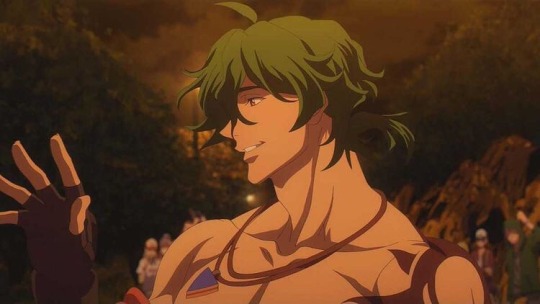

I was wondering what joes necklace was and then I looked at it and thought it’s probably a piece of a skateboard. You can tell because of the layered looking shit on the side.
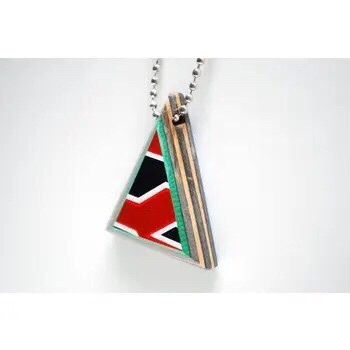
Skateboard jewelry above for comparison. Then I was thinking who’s skateboard? The colour is blue, so hear me out:
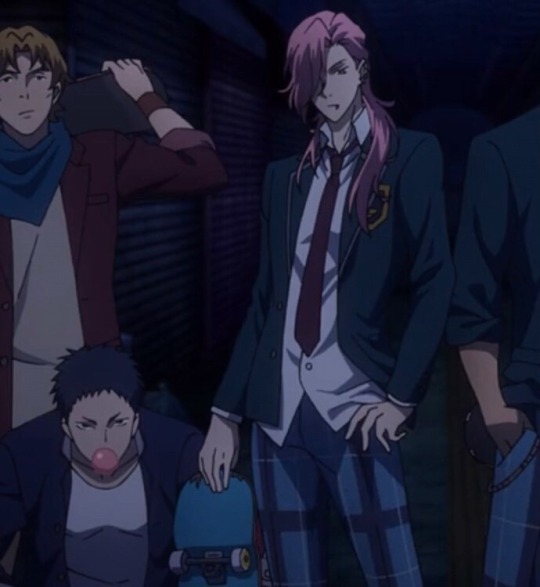
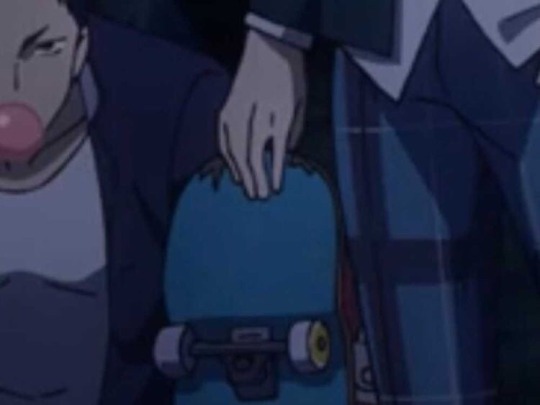
2K notes
·
View notes
Text
I was watching the later parts of Sk8 with people this morning, and I had a realization that is probably obvious to some of you, but hadn't really hit me before.
One of the major themes of Sk8 is connections to others: Having people around to make life fun; dealing with the pain of losing those around you; that despite how painful it can be, you have to try again to have any happiness. I'll start off talking about Langa.
The Langa in the show is a Langa who just lost one of the most important people in his life, his father. Because of this, he's in a strong depression. Snowboarding, a hobby since he was a toddler, gives him nothing, because all that he can think of is that he can't snowboard with his father anymore. He's in a new country, far away from everything he's ever known. He's lost almost everything, and all he can really think about is finding a way to help support his mother, searching for a job.
But then, he has something: He meets Reki, he makes a friend. He learns how to skateboard, a hobby similar to his old one, but this time he has someone he has be with again. He's no longer alone in his depression, he has people in his life, and eventually, he can even laugh again.
When he and Reki fight, he loses the person who brought him to this hobby, he isn't happy anymore. He doesn't want to skate just to skate, he also wants to skate because it's a connection to his best friend. When he's in the zone, is all alone, the thing that brings him back to his senses, back to living, is a reminder of his best friend; "Fun", something that he can only have in the real world, the world with his friends.
Meanwhile, Adam didn't have someone to pull him out of his abyss; Originally, Tadashi helped him not be alone, and through him he met Cherry and Joe, but because of Adam's father, they were pulled apart when it mattered most. Adam was all alone, with no way to have fun anymore. And when that happened, he had two choices: die, or find a different way to live. And he ended up choosing the second, putting winning, the value his upbringing beat into him, above all else.
But he didn't actually want this. He told himself that he was satisfied with winning, that he didn't need connections with other people, but in fact, not having a friend was what led him to his despair. The funeral beef was essentially a suicide attempt; he had nothing left, he didn't win properly anymore, so he might as well die along with his Eve. And if Eve doesn't exist, all the more reason to end it. Because "Eve" wasn't really someone he was in love with, it was an idealized dream of someone, anyone, rescuing him from himself again.
And Tadashi ended up realizing this; The crux of what destroyed Adam was losing connections to people, being successful at his hobbies or his career wouldn't bring him any happiness if he was alone at the top. His current method of bring Ainosuke-sama happiness was flawed. So he trusted Adam's happiness to Langa, someone who he thought could teach Adam have connections with other people again. And his trust was warranted, Langa managed to bring Adam back and teach him that it was okay to want friends, that he had people willing to be friends right in front of him.
You see it with other characters as well. Kojiro and Kaoru, friends since they were 5, with the iconic line, "At least we have each other, right, Kaoru?". Miya, who made it big, but lost his friends, and didn't want it at all. Shadow, who skated so that he could connect with his manager. Reki and Oka, who knew they would never be able to win, but that wasn't the point, was it, what brought them happiness was their friendship with other skaters, skating as a ritual of love. And not in the way Adam thinks of it, "love" as something painful and malicious, love as something that brings people together.
#writing this while having super good (homemade) ramen. feel free to ask my recipe hehehe#braincell posting#sk8#sk8 the infinity#sk8 meta#sk8 the meta#langa hasegawa#hasegawa langa#ainosuke shindo#shindo ainosuke#tadashi kikuchi#kikuchi tadashi
11 notes
·
View notes
Text
Hanakotoba and the Meanings of Flowers in SK8 the Infinity
Ranging from very overt allusions in the text to single pieces of official art, almost every main character in SK8 has been associated with a flower. Hanakotoba, the Japanese language of flowers, is something that the creators were attentive to, evidenced by its mention both in the show itself and by staff in discussion about the episodes, and considering how hanakotoba might have been taken into account in the other examples of flower imagery can add an interesting layer of symbolism to speculate on.
The hanakotoba columns on GreenSnap were my primary source for this post, but I've crosschecked the meanings on multiple websites as much as possible to ensure the factual information here is accurate to the best of my ability. This is quite a long post, so bear with me.
🌹 Roses 🌹
Naturally, the first flower to start with is the one that is directly mentioned in the show itself:
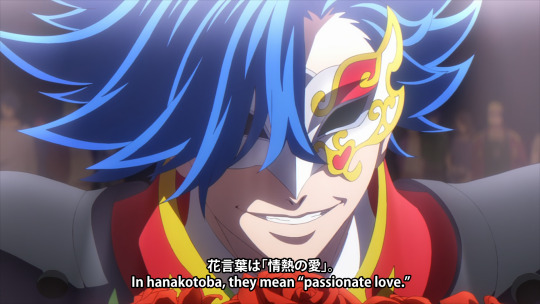
As Adam says, red roses do mean "passionate love", though his particular wording (jounetsu no ai) is slightly paraphrased from how that meaning is typically worded. (If you look up the meaning of roses in hanakotoba, you may see netsuretsu na koi (熱烈な恋) instead.) They can also simply mean "love" and "passion" (ai and jounetsu, as Adam uses in this line), as well as "beauty" and "I'm in love with you."
In Japanese as in English, red roses are a very classically romantic gift, so in the finale and the Blu-ray box art, it seems Adam's passionate love hasn't waned.

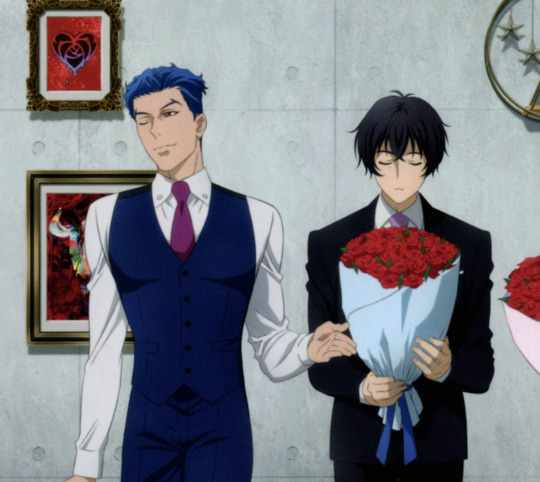
There are also specific meanings for certain numbers of flowers in a bouquet of roses, and while it's never stated how many roses are in the first bouquet Adam brings Langa, extrapolating from how many flowers are visible in the shots and how many are hidden, as well as the bouquet at Adam's birthday display at the 2022 NAMJATOWN collaboration containing 50 flowers (as I was able to confirm from some fans' photos from better angles, that I won't be reposting here as they were personal photos on Twitter) I believe that the bouquet in the show also contains 50, which means "eternity."
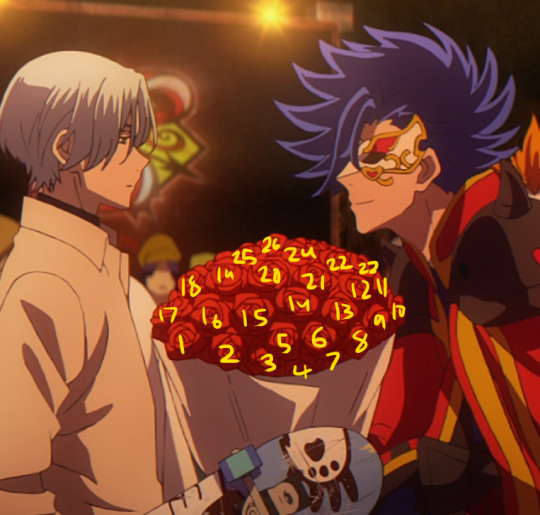
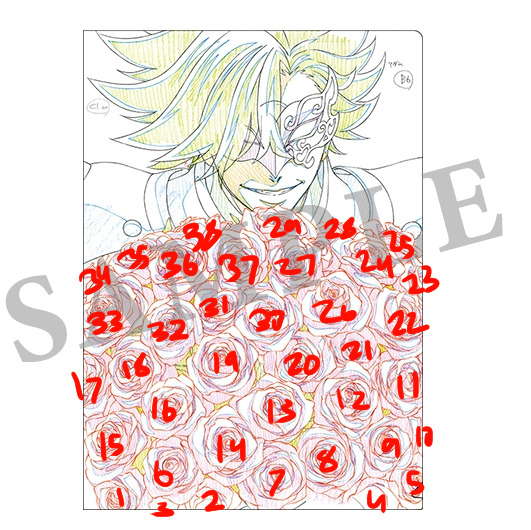
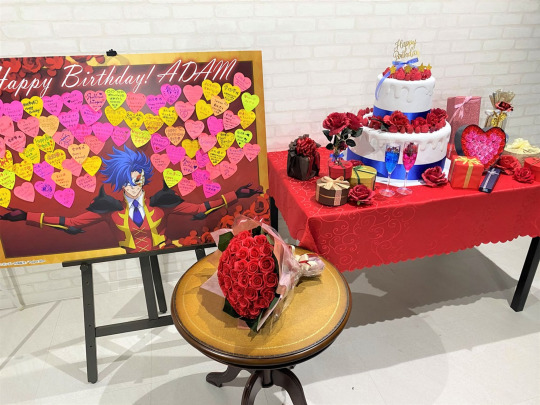
Adam's bouquets to Langa are also not the only times roses appear in relation to him, nor is red the only color they appear in. Several flashback shots of Ainosuke and Tadashi as children feature red roses, which has quite clear subtextual implications, especially alongside the comparison between Tadashi and Langa made in the show itself.
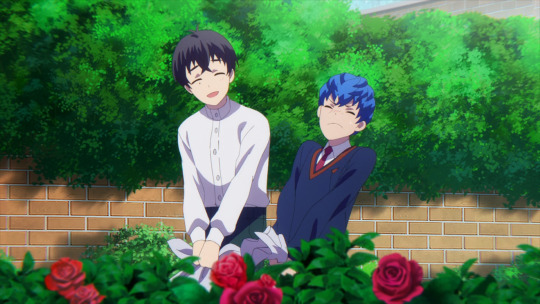
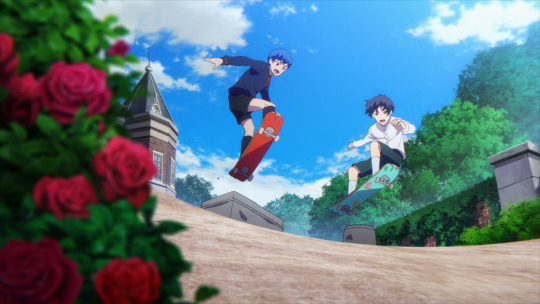
But one prominent flashback also includes pink roses, meaning "deep impression."
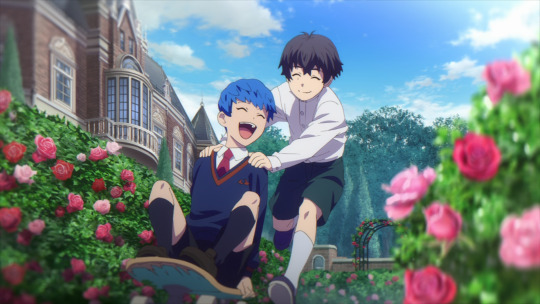
In Ainosuke and Tadashi's last scene together in the finale, there's a vase of purple roses behind them, meaning "pride" or "respect."
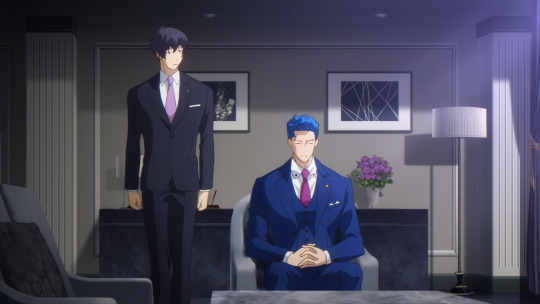
And his graffiti tag from the 2022 Infinity Week art features blue roses, which, along with being in Langa's image color, mean "dream come true", "impossible" or "miracle."
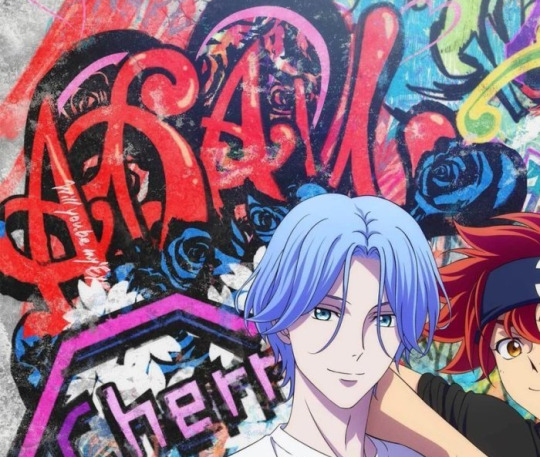
Roses also have a lengthy history of associations with gay men, both in real-life Japanese gay culture and in the boys' love genre, and how this relates to the use of rose imagery in SK8 could (and likely eventually will) be its own post, but it's an extra aspect to take into consideration with Adam especially.
As a bonus, the mangaka for the official manga adaptation also drew Langa and Reki with red and blue roses (respectively) to celebrate the season finale:
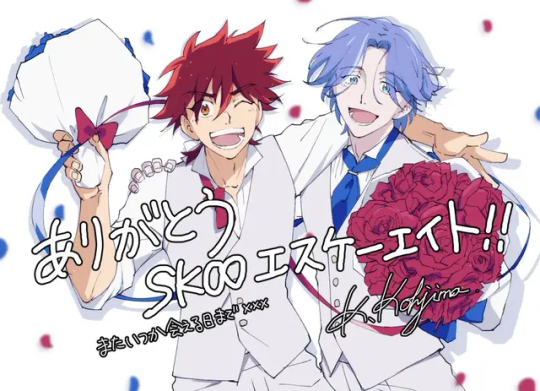
And while Reki is never associated with roses in any more official capacity, Langa does have red roses in his house that are visible in a few scenes:
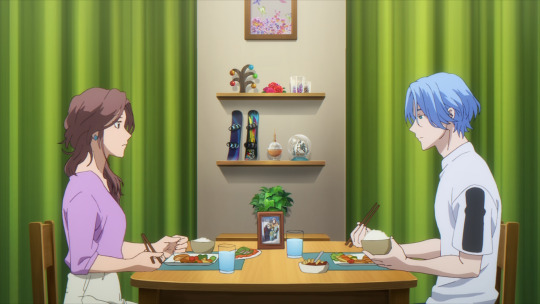
~
🌷 Tulips 🌷
This is another one that's directly confirmed, this time regarding Shadow's bouquet in the ending montage.
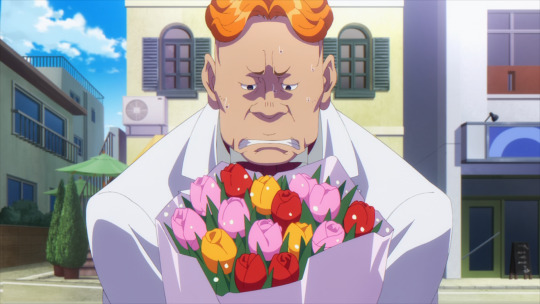
For love bouquets, Adam uses roses, so Hiromi-chan's was tulips and white baby's breath. In hanakotoba, red tulips mean "confession of love." Pink means "sincere love." Orange means "shyness", so we went with these three. Plus, white tulips are "new love" or "unrequited love" so we stopped there… (lol) By the way, in hanakotoba, baby's breath means "innocent love" and "gratitude."
(Episode 12 Director Masatoyo Takada, Skater's Backstage)
Tulips in general mean "charity" and "thoughtfulness", and Shadow is frequently associated with them outside of just this scene, whether on his clothes or in official merchandise. "Tulip" is also the name of the flower shop where he works!
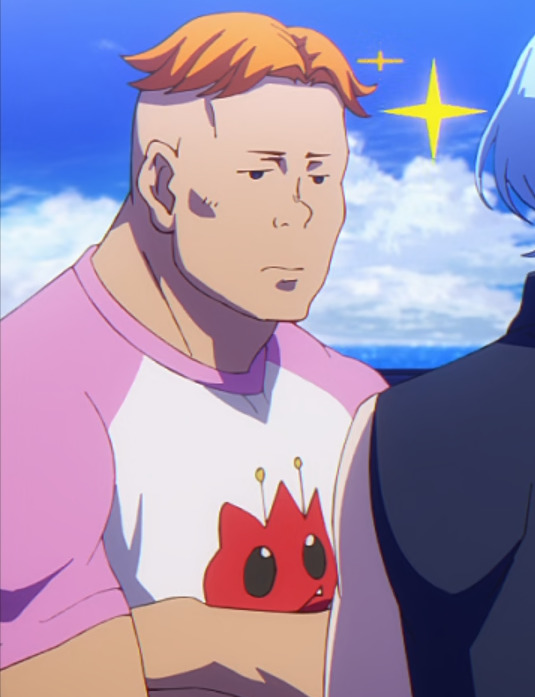
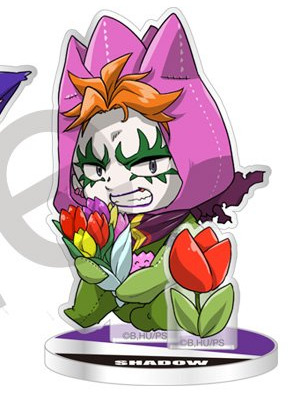

He's holding another bouquet of tulips on the Blu-ray box art, as well, with the same colors as in the finale - but with the addition of the mentioned white tulips for "unrequited love", and yellow tulips, which can mean "honesty", but can mean "unrequited love" (or "hopeless love") too... Sorry, Shadow.
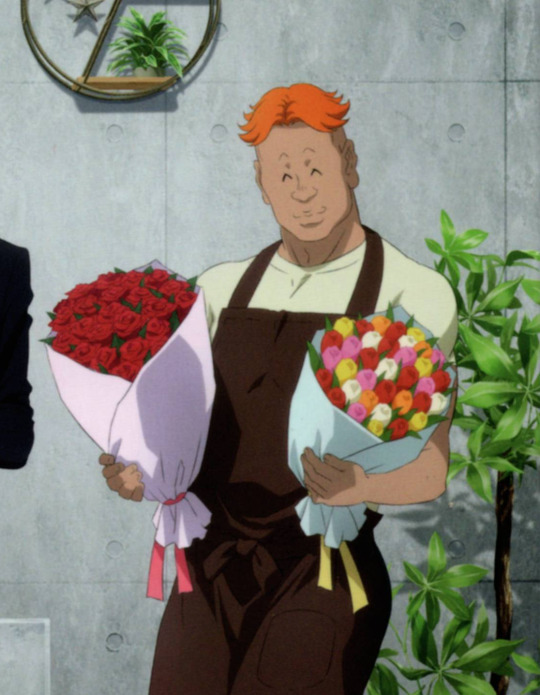
~
🌺 Hibiscus 🌺
Moving away from directly stated connections into slightly more obscure ones, Reki is nevertheless visually associated with hibiscus in several places, both in shots in the show and in his 2021 birthday art.
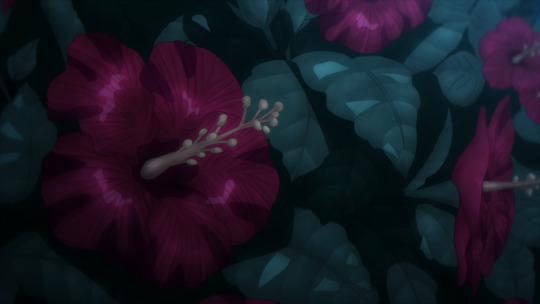
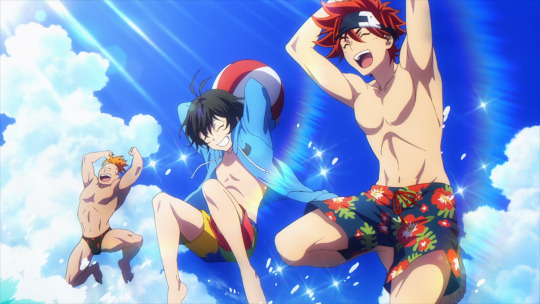
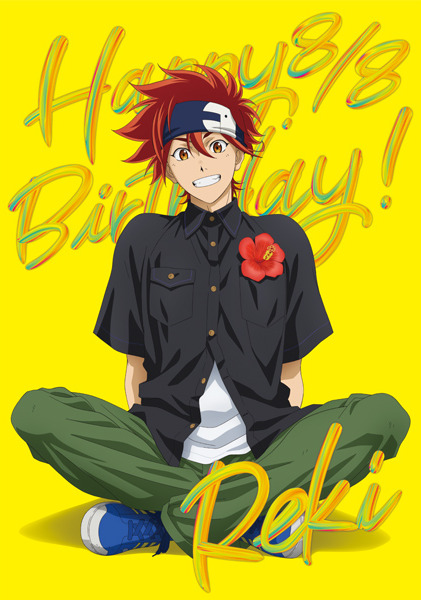
Hibiscus flowers generally can mean "new love", "trust" and "I believe in you" (a meaning thought to originate from Hinduism), while red hibiscus specifically (as Reki is depicted with) mean "bravery."
Hibiscus flowers are also considered as symbol of Okinawa as a whole, making them an especially fitting flower for Reki, who's implied to be of indigenous Ryukyuan descent and is the character who could be considered the most representative of Okinawa (and Langa's new life there) in the show,
~
🌸 Cherry Blossoms 🌸
This one is fairly self-explanatory; Kaoru's surname is Sakurayashiki (sakura being the Japanese word for cherry blossoms), his S name is Cherry Blossom, cherry blossoms feature on his costume and heavily in the decor in his calligraphy studio, et cetera. As one of the most well-known and famously Japanese flowers, they're well suited to Cherry's traditional Japanese image, and the whole aesthetic of his character is themed around them. Even his birthday is on March 27th, Sakura Day in Japan.
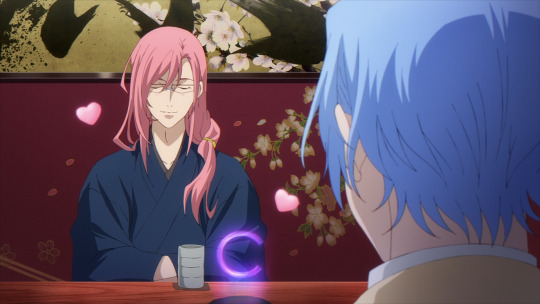
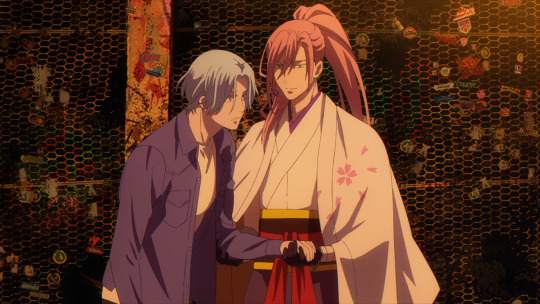
In hanakotoba, cherry blossoms' most well-known meaning is "moral beauty", a phrase referring to the beauty of someone's personality or character. They can also mean "graceful woman" or "pure-blooded", and the specific species of cherry blossom that the ones in Cherry's design resemble (somei-yoshino cherry blossoms) can additionally mean "noble" or "innocent." The fact that the same flower with such elegant meanings is related to both his public and S personas adds to the characteristic duality between his outward appearance and private personality.
While not specifically hanakotoba, the French meaning of cherry blossoms also appears to be well-known in Japan - "ne m'oubliez pas", or "don't forget me", associated with ending relationships.
~
💮 Chrysanthemums 💮
Another flower associated with a character through their surname, chrysanthemums are the "kiku" (菊) in Kikuchi. A chrysanthemum also features prominently in the design on Adam's skateboard.

Chrysanthemums also appear on both Adam and Tadashi's clothes in a few pieces of official art.
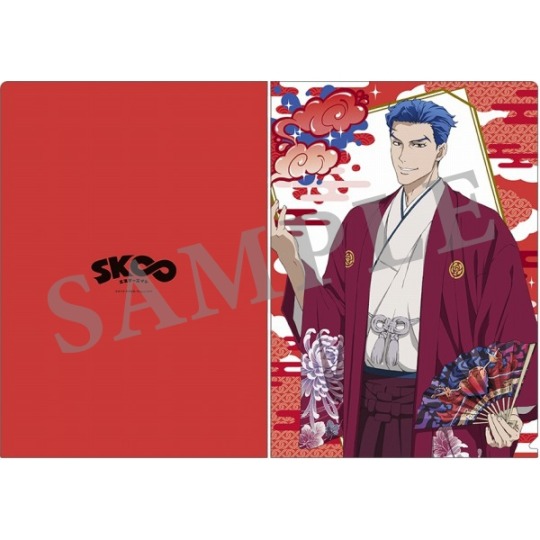
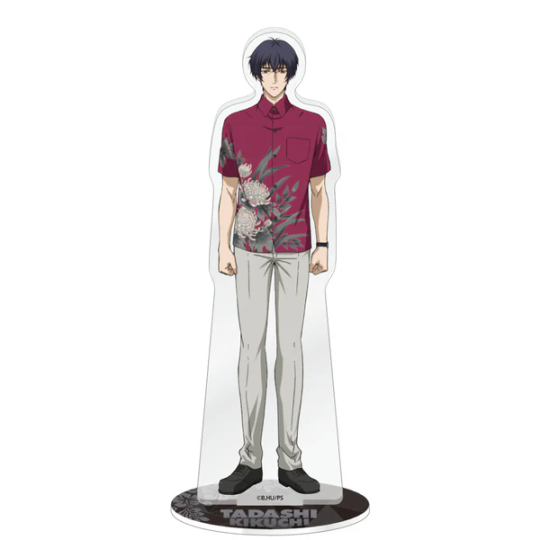
Chrysanthemums' meanings in hanakotoba are all variations of "nobility" and "purity." They're a flower with great cultural significance in Japan, being the crest of the Imperial family, and often appear as a symbol of Japanese society itself - including on the badges worn by both Diet members such as Ainosuke and even certain ones worn by their secretaries, making this flower one that's representative of a very important aspect of both their lives.

While there's no particular history to this meaning, due to the romantic color, red chrysanthemums such as the one on Adam's board can also mean "I love you."
According to director Utsumi in the 2022 Infinity Week livestream, the chrysanthemum on Adam's board was a happy accident, as Thomas Romain, the artist who designed the board, didn't know Tadashi's name or anything about his history with Adam when creating it. The double layer of symbolism is an incredible coincidence!
~
🌻 Sunflowers 🌻
Joe doesn't have any particular connection with flowers in the show himself, but there is one piece of official art featuring him with sunflowers, which complement the strong association he does have with the sun.
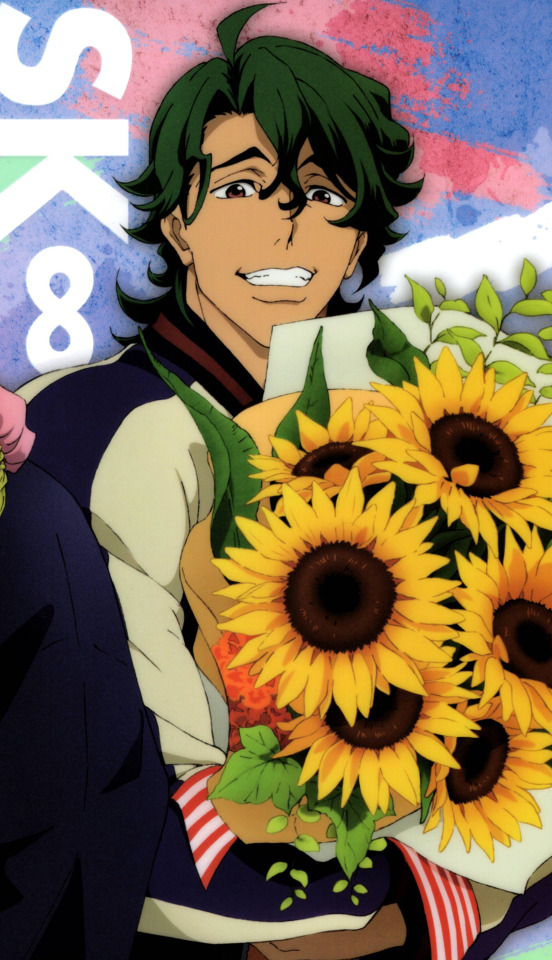
In hanakotoba, sunflowers mean "admiration", "longing" or "I'm only looking at you" - originating from the way sunflowers will always turn to face the sun. As this particular piece of official art was for a magazine feature for White Day (a Japanese holiday where men receive gifts from women they gave gifts to on Valentine's Day), perhaps they're meant to be a gift to him. As Joe's stronger association is with the sun itself (his tattoo is of the sun, his board has the word "sole" - sun in Italian - written on it and a sun incorporated into the design, his restaurant's name (Sia la Luce) translates to "let there be light") he could be seen as the sun that the sunflowers (his admirers) would look towards.
Along with the hibiscus in the image, Reki's birthday event in 2021 also featured sunflowers as part of the display, fitting his yellow image color.
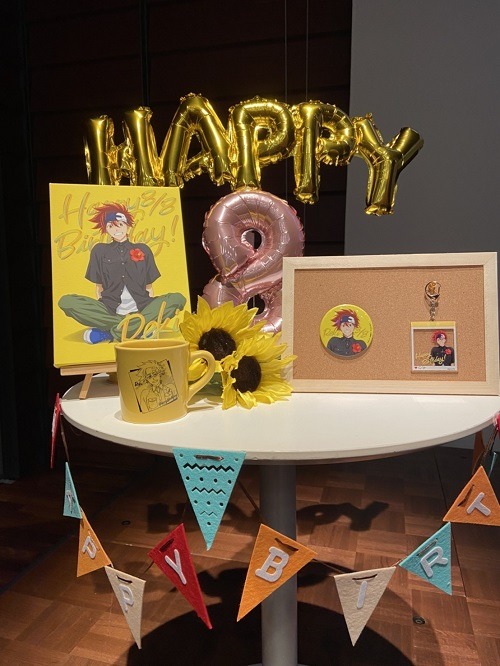
~
❄️ Snowdrops ❄️
And finally, one more case with only a single piece of official art - but one with a very interesting history behind its meanings. In Langa's 2022 birthday art, he's shown holding snowdrops - a natural association with his S name and the fact that he's a former snowboarder.
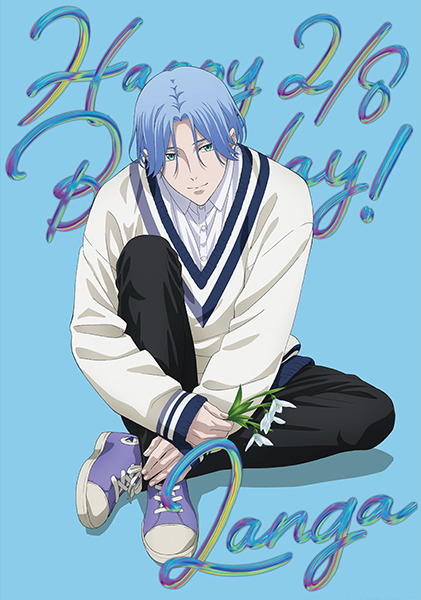
In hanakotoba, snowdrops mean "hope" and "comfort." These meanings are said, as you will find on any Japanese hanakotoba site, to originate from a story about Adam and Eve dating back to at least 1925, if not earlier (with 1925 being the earliest version of the story the Japanese Wikipedia page on snowdrops is able to cite.) As the story goes, after Adam and Eve were cast out of the Garden of Eden, an angel took pity on them suffering in the winter cold and turned the falling snowflakes into snowdrops, to console them and give them courage. In that 1925 version of the story, the first snowdrop was specifically a gift to Eve:
The Snowdrop Legend When the first winter lay white upon the earth, Eve sorely missed the beautiful things of the field. An angel who pitied her seized a snowflake and, breathing upon it, bade it live, for her delight. It fell to the earth a flower, which Eve caught to her breast with gladness, for not only did it break the spell of winter, but it carried assurance of divine mercy. Hence the flower means consolation and promise.
With both the superficial connections of being winter flowers named after snow and their connection to SK8's intentional biblical themes (as producer Mari Suzuki described the show as a whole as "the story of Adam searching for Eve" in Animedia March 2021), these have some of the deepest meanings of any of the flowers depicted, despite only appearing in a single piece of art.
The flower imagery SK8 uses is fascinating and surprisingly layered, especially knowing the deliberate attention to hanakotoba that was paid in certain cases, and it'll be interesting to see how it might continue to feature in the future.
#sk8#sk8 the infinity#meta#sk8 meta#adam sk8#ainosuke shindo#hiromi higa#reki kyan#kaoru sakurayashiki#kojiro nanjo#tadashi kikuchi#langa hasegawa
118 notes
·
View notes
Text
Genesis 2:18




(english translation from the new international version, japanese translation from the japan bible society interconfessional version)
skateboard anime has driven me to comparing bible translations, and the realization that the dialog at the end of episode 11 (particularly tadashi's) appears to be referencing the bible verse first describing the creation of eve. sure, maybe a stretch, but this line comes only about 20 seconds before "let's fall together, because we're going to become adam and eve", and there's enough attention to detail to the biblical references in this show for adam's board in the finale to be missing a rib on one side.
tadashi's use of ふさわしい here is also tying back to an earlier piece of dialog in sk8 itself, a use by adam's aunts when the idea of ainosuke's arranged marriage first comes up:

this idea of adam being in need of a "suitable" partner, and the fundamental clash between his family's intentions for him to marry a woman and his own genuine desires as a gay man, form such a fundamental throughline to his story, and the way that this is part of his overarching biblical storyline really shows the care that was put into the writing - and that the show really is, as the producers describe it, "the story of adam searching for his eve."
70 notes
·
View notes
Text
sorry if it's a bother to jump on this but i wanted to add to these because a bunch of these things are exclusive to the dub/different between the sub and dub so i thought it'd be interesting to add those! as well as a couple language/culture notes in general
when the other students are whispering about langa when he first comes in, the first thing one of the girls says is 外人 - gaijin, a very informal word for foreigners that is like… not a slur, but considered derogatory enough that it's in bad taste. it doesn't seem to be being used in a mean-spirited way here but given this is a series with technicolor anime hair i think it's interesting to note that in-universe langa does immediately look foreign!
reki's first impression of langa originally is that he was totally spaced out, rather than nervous. reki and oka's convo is pretty much the same otherwise, though oka suggests langa doesn't speak the language at all rather than that he forgot, which ties into...
oka describes langa as a 帰国子女, which is a bit of a complicated term that basically means "a child with japanese citizenship who lived overseas for at least part of their childhood" - the dub takes this to mean langa was born in okinawa but despite the literal translation being "returnee" it actually does apply to children of japanese parents born in foreign countries, and there isn't any explicit clarification in langa's case (other than that they were living in canada by the time he was two years old.) i usually see it interpreted in japanese fandom that he was born in canada, but the phrasing can go either way.
another reblog has some useful notes about koseki/why langa goes by nanako's maiden name! (also worth noting that oliver is later credited as just oliver, not oliver hasegawa - canada doesn't have any such rules about both parents in a household having to have the same name so oliver probably did not change his name, and langa may have just changed his name to match nanako's when they moved so he could be in her family registry, this isn't uncommon for half-japanese children)
jp!langa speaks japanese fine, more formal and less slang-y than reki but he does come off as fluent (there's a joke a couple eps later about him pretending he's worse than he is to make fun of miya)
japanese swearing is hard to translate 1:1 to english but jp!reki does swear/uses rough language that would get translated as swearing! he can talk pretty expectedly crudely for a 16-17 year old boy, the localization just doesn't really let anyone swear (though slut/bitch/hoe are fine i guess)
langa is sitting in seiza during his interview with cherry - a formal traditional way of sitting in japan that is notoriously difficult for foreigners to maintain and will typically give you pins and needles within minutes if you're not used to it
the drivers' license exchange - langa says he has one, for 中型, but this is out-of-date terminology that nowadays refers to a license for midsize trucks you have to be 20 for. 中型 used to refer to a license for a motorcycle, which you can get starting at 16, so langa is using it in that sense and either okouchi didn't know the term changed or langa learned the wrong word (which makes sense given nanako hasn't lived in japan for at least 15 years.) so langa has a motorcycle license and is perfectly legally using oka's bike!
shadow calling himself a clown is only from the dub, he originally calls himself "the antihero of S", i have no idea why they changed this one ashdfgjk (i think the dub team might have thought his makeup is supposed to be juggalo makeup? it's based on KISS, specifically gene simmons!)
jp!cherry's voice gets deeper and rougher at S compared to his work voice! ep 1 is one of the least drastic delinquent cherry moments but it's a touch i really like and want to point out because i'm biased
there's actually some word of god about langa recognizing people (instantly being able to see through his dad's santa costume) where he's described as having "keen natural intuition" so... he really just wasn't paying attention to reki in class i guess, sorry reki...
also as a bonus: the official guidebook has some really nice references of reki's room! i haven't seen a good background illustration for miya's anywhere unfortunately
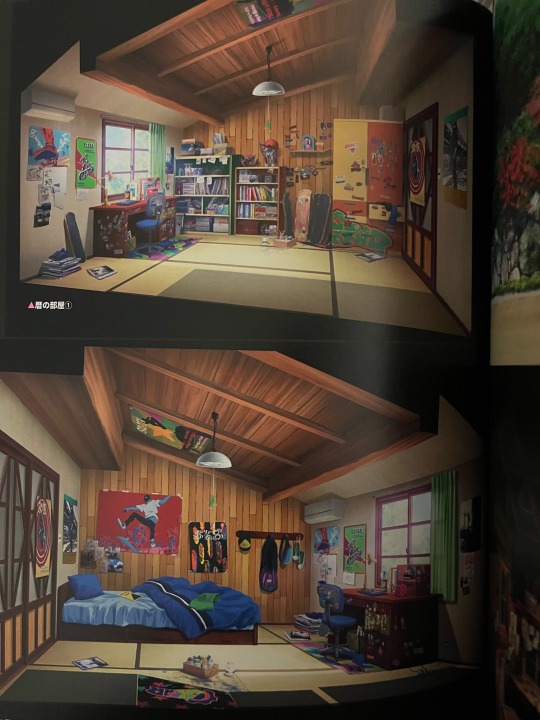
Notes on Ep. 1
Dunno how helpful these will be to people, but here's what I got:
Reki used to watch all sorts of superhero shows (kids shows; pre-school times)
"Do you know what true happiness is?" (premise of the show) -> R: "Well that's messed up; you want kids to go that deep before they're even in school?"

Cars -> opp. to Canada (driver on the right) ==> LANGA CAN'T FUCKING DRIVE
Langa's reaction to the Okinawa scenery: "It's just weird to not see snow everywhere" -> Set in ~April => Used to spring snow (QC???)
Reki = Right handed
Reki = clearly good at math (Free hands all his estimations and calculations in his notebook)
Reki's first impression of Langa is that he's a nervous wreck
(We know that it's just that he's god awfully awkward)
Oka suggests he isn't fluent; Reki assumes he is because Nanako is a native (NOT SO FUCKING SURE ABOUT THT BUDDY I DONT THINK HE'S THAT GOOD IN JAPANESE LIKE HE CAN MANAGE BUT IDK HOW FLUENT HE //REALLY// IS)
Reki goes thick with the self deprecation (mood though) + inferiority complex
His voice goes lower when he feels like shit, goes high when excited
Langa's not used to being on his knees (legs/feet go numb after being on his knees during the interview)
Reki actually really does not swear (not even ass. "Saved my butt" (please just say ass, kid))
Langa's face recognition???? Reki = stranger, doesn't realize they're in the same class (maybe because there were a lot of new kids he didn't really notice/pay attention? But one on one with Cherry meant he really analyzed his face?? see later notes)
Reki's #1 = share love of skateboarding (Doesn't hold a grudge/isn't petty after get frustrated at Langa or not recognizing him)
Langa gets moody when he fucks up/isn't good from the start and people make slightly fun of him
CHERRY SAW HOW SHIT LANGA IS ON A BOARD
Oka really said "I dont give a fuck if this kid can't /actually/ drive, he's good enough" and Langa said "Fuck yeah! Money!" (but. without emotion except the sparkle eyes)
R: "I'm about to change your life"
(Not to scale)

Both boys have long/wispy bangs
Reki = frozen panic
Langa = extreme confidence but will throw in a "I think" to soften if he's wrong
Cherry's a FUCKING BITCH
-> he saw Langa fail big time and he's still sending him to his death just for a little fun (also. He won't hire a minor but he'll kill him??)
-> Langa's facial recognition? No one can tell that Cherry = Kaoru, but Langa had a ep. OHSHC moment 💡
Cherry just wants a front row seat of Langa busting his ass, and invites Reki to watch with him (?? Reki clearly is there because he wants to see Langa live, but like?? Cherry confuses me tbh)
Shadow extremely cocky + refers to self as "clown punk"
Calls Langa "Kiddo"
Langa swivels on his board just like on a snowboard
-> goofy boarder (aka right foot naturally forward, but can control with both as with snowboarding -> quite experiences (duh))
Joe's commentary is truthful (Langa doesn't have an assured win); not bitch like Cherry (though skeptical of Langa, but tbh so would I)
"Call me crazy but I know what I saw; Snowflakes began to fall right here in Okinawa."
68 notes
·
View notes
Note
Hello, if you don't mind, can I ask, who are your top favorite romantic relationship's couples in any media, like anime/manga, tv series, books, etc (can be canon or non-canon)? Feel free if you want to write the reasons or not of why you love them....Thanks if you want to answer....
Ooh how fun! I should just screenshot my ao3 dash lol. Let's see... almost all of these are all animanga (and not canon), but in order of my love for them at this particular moment in time:
TodoBakuDeku
BakuDeku
KilluGon
MatchaBlossom
SatoSugu
ShiGuang
TigerGhost
SasaMiya
ShunMio
KazuRei
Now, explanations, *spoilers*, and honorable mentions below the cut!
TodoBakuDeku (My Hero Academia)
Obviously not canon and never will be but oh does this ship have a chokehold on me. I just think this trio is so balanced in every way. Like we have our precious TodoDeku who connect by being nerds and the sweetest boys. Then we also have TodoBaku who are just lovely little menaces. And, of course, BakuDeku--can't beat friends to enemies to lovers. And then they all come together to form a masterpiece. Idk I just love this ship so much.
BakuDeku (My Hero Academia)
So I honestly really wasn't into this ship too much until reading the final war arc and meta. Other people's viewpoints changed my mind! Hori has done a really great job of portraying BakuDeku's complex relationship in the manga (for however you view their canon relationship). So like idk how can I not ship For-the-Rest-of-Our-Lives Katsuki with Control-Your-Heart Izuku?
Sidenote: I almost didn't include this on the list because I tend to only really ship this pair while reading the manga. I never shipped them in the anime unless it was TodoBakuDeku with Deku as a hinge. And I don't even read many fics with just Katsuki and Izuku. I just feel like fandom BakuDeku feels incomplete without Shouto for some reason. Like I'm Team BakuDeku for the manga, Team hinge TodoBakuDeku in the anime, but throuple TodoBakuDeku in the sanctuary of my mind/on ao3. (Maybe that'll change once I start watching Season 7 though.)
KilluGon (Hunter x Hunter)
I only watched this anime this year but ohmygod I immediately fell in love with Gon and Killua. They are so precious. I mean, Killua is just a little smitten kitten. And Gon? He's in it. Anyway, love their dynamic and of course I ship them. Gon is Killua's light after all!
MatchaBlossom (Sk8 the Infinity)
Literally just started shipping this so I'm in the throes of obsession rn but their dynamic? *chef's kiss* (hehe, you like what I did there?) Childhood friends? Pining while the other falls for another? Realizing feelings? Already married bickering old couple? Give me all the headcanons please!
SatoSugu (Jujutsu Kaisen)
I mean, c'mon. Tragic gays are my weakness. They're gonna be OG for me. No one can compare. They're on a different level. All I want is for them to have hopped on a plane and gone somewhere they can finally find peace, is that too much to ask? (Gege??)
ShiGuang (Link Click)
Again, I said I like tragic gays. But god, I do hope they don't end up too tragic! I love this pairing. They balance each other out well. We have puppy dog Cheng Xiaoshi and cat Lu Guang. Perfection thx.
TigerGhost (Nicktoons Unite)
Ok so this crackship was brought on by my serendipitous viewing of Nicktoons Unite fanart on this beautiful app and subsequent reading of all their fics on ao3 (a grand total of four, btw). And I'm obsessed. I was a diehard Danny Phantom fan as a kid (we stan our queer/genderqueer/bisexual/trans ghost boy). And I never watched El Tigre as a kid, but the way the fandom portrays him and Danny together just hits. Salty and sweet with a lil bit of darkness? Yum.
SasaMiya (Sasaki to Miyano)
First canon ship on this list lol. You want fluff? You got it. Give me some good pining, consent, and mutual respect, thank you.
ShunMio (Stranger by the Shore)
Second and last canon ship on the list! Love me some good ole sun and moon. Idk their story is so cute. Plus, I like how Kii Kana portrays Shun's feelings regarding his sexuality and how that affects his relationship with Mio. It's relatable.
KazuRei (Buddy Daddies)
I mean, this is practically canon, right? Well, at least queerplatonically (which we stan). Love our little found family. This anime had such a cute and goofy premise, how could I not fall for this ship?
(Honorable mentions: TodoDeku, TodoBaku, Labru, DabiHawks, Renga, VashWood, Kappa x Siren, Boyfriends, EraserMic, ItaFushi, InuOkko, ShokoHime, HaiNana, LeoPika, KudoIchi, TogaChako)
#todobakudeku#bakudeku#killugon#matchablossom#satosugu#shiguang#tigerghost#sasamiya#shunmio#kazurei#ships#ask
23 notes
·
View notes
Text
Hi, I'm Monique 🌸 I do a lot of writing and rambling about manga and anime! To make it easy to find my posts, I've included links to my analysis posts, writings, and my AO3 below!
Note: This blog and these posts are not spoiler-free. Please do not repost or post on other websites, tiktok, etc. Be sure to write ‘prev tags’ if you agree with my tags, before rbing
-> weekly/monthly manga & manhua I read: Bungou Stray Dogs (bsd), Spy x Family (sxf), 19 Days, Kuroshitsuji, Astro Royale (nna), Wind Breaker (satoru nii- wbk), Chainsaw Man (csm). Series Ended/Complete: Jujutsu Kaisen (jjk), My Hero Academia (bnha), Dr. Stone (dcst - main & 4D Science ended), Tokyo Revengers (main ended), MHA: Vigilantes, Demon Slayer (kny), Haikyuu!! (hq!!)
☆ I keep this navigation post and all lists regularly updated so check in weekly! For Viz titles, I read the official translation via the Shonen Jump app.
🌸 My Analysis/Ramblings Main Tags
My longer posts are my analysis & typically delve into actual meta/analysis and are tagged as analysis. My shorter posts are random thoughts that come to mind as I read instead of a deeper analysis, they’re light, and I will elaborate in the tags if I have more to add. In my thoughts tags, you will find a mixture of both thoughts and analysis.
• weekly/monthly manga thoughts tags (new!-> 27 Feb 2024): sxf thoughts* || 19 days thoughts* || bungo stray thoughts* || nna thoughts* || wbk thoughts || csm thoughts* (still read but no longer posting thoughts) || [next new sxf viz: 2 March ] [next new astro royale: 2 March] • completed/ended series thoughts: jjk thoughts || bnha thoughts* (special one-shot )|| dcst thoughts • long analysis/rambling main tag: idk I'm rambling* || Monique answers things* || see each series navigation list below for more posts and tags
🌸 My Analysis by Series
I've organized my analysis & thoughts posts in lists for each series below, and I also update each series link regularly! Also, reblogging my posts helps more fans find them, so consider rbing if you enjoy!
• Bungou Stray Dogs analysis posts (newest!-> 3 Feb/ Ch 121) || thoughts + analysis about Chuuya's corruption, Dazai, the aftermath of Odasaku, Akutagawa's health, the current manga arcs, & more [next new ch: ~3 March] 🌸 Complete/Ended Series Analysis • Manga: Jujutsu Kaisen (JJK) analysis || My Hero Academia (BNHA) analysis || Dr. Stone (DCST) analysis || Tokyo Revengers analysis • Anime: Sk8 the Infinity || Yuri!!! on Ice
🌸 Anime thoughts/ramblings by series
Yakuza Fiance x || Blue Lock x || A Sign of Affection x || Atarashii Joushi/My New Boss is Goofy x || Link Click/Shiguang Daili Ren x || Haikyuu!! x || The Yuzuki Family’s Four Sons x || Life Lessons with Uramichi Oniisan x || Buddy Daddies x || Food Wars + some Toonami x
🌸 Gifs I made x || Rather read a fic? Check out my AO3
#nna#bsd#jjk#bnha#wbk#19 days#tokrev#sgdlr#spy x family#astro royale#bungou stray dogs#dcst#hq!!#my hero academia#jujutsu kaisen#blue lock#shiguang daili ren#dr. stone
10 notes
·
View notes
Text
20 Questions for Fic Writers
(I don't know anybody here, so nobody tagged me, I just thought it'd be fun, sorry if I've committed Tumblr crimes lol)
How many works do you have on AO3?
8! But if you don't count my original story snippet it's 7... but if you count my one fanfiction-dot-net-only fic that I've been too lazy (and slightly embarrassed bc it's old) to transfer over... it's 8 again lol
2. What's your total AO3 word count?
With my original story snippet: 16,705 Without my original story snippet: 15,047 And for fun... Including my fanfiction-dot-net-only fic but not original story snippet: 105,467 (lmao)
3. What fandoms do you write for?
Oh boy here we go. Well. The fandoms I currently have fics posted for are Danny Phantom, Natsume's Book of Friends/Natsume Yuujinchou, Batfam/DCU (and does the Teen Titans animated show count as a different fandom or nah?), Spider-Man/Marvel, and Harry Potter. However. The fandoms I have fics for including unposted WIPs are as follows: Danny Phantom, Avatar: The Last Airbender, Ben 10, My Hero Academia/Boku no Hero Academia, Batfam/DC, The Morose Mononokean/Fukigen na Mononokean, Gravity Falls, Randy Cunningham: Ninth Grade Ninja, Star vs the Forces of Evil, The Magnus Archives, Spider-Man/Marvel, How to Train Your Dragon, Rise of the Guardians, Harry Potter, Natsume's Book of Friends/Natsume Yuujinchou, Sk8 the Infinity, Bungou Stray Dogs, Be More Chill (the musical), the Rick Riordan universe (Percy Jackson, etc.), and Big Hero 6.
4. What are your top 5 fics by kudos?
So I don't have a lot of fics actually posted and obviously I can't count the one that's only on fanfiction-dot-net so... 1) They Say Right, Let's Go Left (Batfam Titans Tower AU; 2,871 kudos as of 11/12/2023) 2) Skia Tou Myalou (Batfam Meta!Tim AU; 1,832 kudos as of 11/12/2023) 3) How To Summon A Halfa (Without A Ouija Board) (Danny Phantom 30-minute oneshot; 178 kudos as of 11/12/2023) 4) And Thus, I Repent (Danny Phantom/Teen Titans crossover preview posted for International Fanworks Day 2022 that still hasn't been updated; 144 kudos as of 11/12/2023) 5) What A Lovely View (Natsume's Book of Friends/The Morose Mononokean crossover oneshot for International Fanworks Day 2021; 74 kudos as of 11/12/2023)
5. Do you respond to comments? Why or why not?
As much as I can! A lot of the time I'll respond to a lot of comments after I post the story but forget as time goes on lol. I appreciate them so much nonetheless! I'm always flabbergasted that someone took the time to tell me their thoughts and feelings about MY story, it's so cool. Gotta make sure they know how cool I think it is and they are!
6. What is the fic you wrote with the angstiest ending?
Okay... so I haven't actually had any angsty endings per se, at least none that I've posted. Because of where the prologue chapter leaves things for Fractured (Danny Phantom/My Hero Academia) it's currently the most angsty thing I have posted, but I haven't posted anything past the prologue chapter and the story will get more lighthearted. I once accepted a request to write a major character death oneshot, but I never was satisfied or finished it. If I had, it would definitely be the most angsty. As for WIPs/unposted things... I have a "choose your ending" Tim Drake AU series in the works and the "bad ending" will be the most angsty ending I've ever written or planned once I get there.
7. What's the fic you wrote with the happiest ending?
Oh, most of what I write has happy endings, I'm honestly a hopeles romantic. I'd call on Skia Tou Myalou (Batfam, Meta!Tim AU) for that probably, mostly because half of They Say Right, Let's Go Left's (Batfam, Titans Tower AU) fluffy ending is in the author's note and also it's a oneshot. As for WIPs/unposted things... I have no idea lol.
8. Do you get hate on fics?
The only real hate I ever got was on my fanfiction-dot-net-only fic and I still don't know what the guy had against me other than being mad at my author's notes and that I was following a canon plotline... after I said that that's what this fic was going to do before branching out after I finished the rewrite. The positive feedback completely outweighed them though! Thanks to those folks!
9. Do you write smut? If so, what kind?
NOPE. Not my thing, totally chill if it's yours. I am too sex-repulsed asexual for that lmao.
10. Do you write crossovers? What's the craziest one you've written?
ABSOLUTELY! You may not believe it from what I have posted (or actually maybe you will) but my main genre is crossovers, specifically involving dimension travel. I wouldn't call any of them particularly weird combinations honestly. Maybe What A Lovely View (Natsume's Book of Friends/The Morose Mononokean) or my WIP "Nanashi" (Danny Phantom/The Morose Mononokean) because of the more obscure fandoms.
11. Have you ever had a fic stolen?
Thankfully no, and I always make sure my fics are tagged where exactly I've reposted them under my own accounts so there's no misunderstandings.
12. Have you ever had a fic translated?
Not yet, that'd be the dream, wouldn't it?
13. Have you ever co-written a fic before?
Nah, I don't really have people I know in the fanfic community.
14. What's your all-time favorite ship?
That sure does change monthly! Currently I'm vibing with Reki and Langa from Sk8 the Infinity, can't wait for the next season of that show!
15. What's a WIP you want to finish but doubt you ever will?
I have a couple of unposted WIPs that I call "cancelled" WIPs because I never plan on continuing them, it's mostly a couple Danny Phantom crossovers from my early days. As for posted things, work on Fractured (Danny Phantom/My Hero Academia) is actually trudging along pretty well even though I haven't posted anything, I had to completely reorganize the notes for it into a section of their own because they outgrew my standard page formatting! And Thus, I Repent (Danny Phantom/Teen Titans) is at a wall though I plan on continuing it eventually. What's really been getting me is my fanfiction-dot-net-only fic that's been going on since before it was first posted in 2019 but at a standstill since 2020 and the pandemic. I've really been struggling to get any work done on it, which sucks because it's my longest fic but it's also from the early days and I have a love-hate relationship with it and its fandoms.
16. What are your writing strengths?
Hesitantly... imagery? Scene description? I love writing a good, visceral chunk of text that makes you feel like you're there. It lands... sometimes lol
17. What are your writing weaknesses?
Trying to develop relationships. Romantic, platonic, any. I have no idea how to pace these things or sometimes how to move them forward, I'm not a super social person and I don't have any experience in romantic relationships, so it's harder to pull from my own life. I'd love to get better though, and relationships are so important to writing and fun to see unfold.
18. Thoughts on writing dialogue in another language in fic?
I think it's fine as long as you're respectful of the language and culture. Like, the title of Skia Tou Myalou (Batfam, Meta!Tim AU) (sorry for the lack of accents, I don't have access to the right keyboard right now) is in Greek because the language is cool af, and I had a reader confirm it was correct. Some people get worked up specifically over including Japanese honorifics in anime fics sometimes, but I think it adds a lot of nuances to character relationships so as long as you do your research and apply them correctly and respectfully, I don't mind it at all. I personally prefer to do so when writing fics in anime fandoms where they're used for that extra level of attention and detail. Y'all have no idea how long I spend researching this stuff!
19. First fandom you wrote for?
This one was never posted and deleted way back when, but when I was in middle school I wrote a Percy Jackson and the Olympians OC oneshot lol
20. Favorite fic you've ever written?
Y'all trying to make me choose? Betrayal... and it changes every time I work on one lol. Currently I have a certain fondness for an unposted Bungou Stray Dogs Chuuya-joins-the-ADA-with-Dazai AU but my favorite posted is Skia Tou Myalou (Batfam, Meta!Tim AU). Sure it's a little eh in places but I love elemental-ish powers and Tim Drake is my favorite Batboy lol
#20 questions#writeblr#writing#fanfiction#danny phantom#avatar the last airbender#ben 10#my hero academia#boku no hero academia#dc#batfamily#the morose mononokean#fukigen na mononokean#gravity falls#randy cunningham 9th grade ninja#star vs the forces of evil#the magnus archives#spiderman#marvel#how to train your dragon#rise of the guardians#harry potter#natsume's book of friends#natsume yuujinchou#sk8 the infinity#bungou stray dogs#be more chill#rick riordan#percy jackon and the olympians#writer
17 notes
·
View notes
Text
there's pretty much word of god answers on this, believe it or not! in the june 2021 issue of animedia, utsumi was interviewed on the points where she fell in love with each of the characters (minus miya and shadow), and for langa she picks the episode 1 beef.

the last sentence (after her describing his jump) is "when i saw snow, i was captivated by him just like reki!" but the word literally meaning "captivated" is 見惚れる, while 惚れる is the word used in the rest of the article to mean "falling in love." so in context of the rest of the interview, 見惚れる here suggests something more like "falling in love at first sight."
meanwhile for langa, in the september issue of animedia the same year, there's the 8 questions about dating for each of the characters, and reki comes up in utsumi's answer about what fashion langa would find attractive:

"he doesn't seem to get excited over appearances. even if you look at reki, it wasn't as if he was like 'reki is amazing!' from the start, but rather that while spending time with him he became attracted to who he is inside."
(a fandom friend of mine who's a native japanese speaker also explained that 惹かれる, the word used for "attracted to" for langa->reki, can refer to something developing slowly, while 見惚れる implies a more instant thing)
ok y’all ready for a very original poll?
feel free to explain your vote in the tags!!!
#fandom: sk8 the infinity#renga#meta#you can also see it in the show pretty well#langa's really just not that impressed with reki initially#in his own words he only realizes just how important reki is to him AFTER they've already fought#while reki's more attached right from the start
154 notes
·
View notes